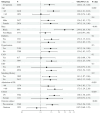Obesity, Inflammation, and Clinical Outcomes in COVID-19: A Multicenter Prospective Cohort Study
- PMID: 38635301
- PMCID: PMC11479687
- DOI: 10.1210/clinem/dgae273
Obesity, Inflammation, and Clinical Outcomes in COVID-19: A Multicenter Prospective Cohort Study
Abstract
Context: Obesity is a risk factor for coronavirus disease 2019 (COVID-19)-related outcomes; however, the mechanism remains unclear.
Objective: The objective of this analysis was to determine whether inflammation mediates the association between obesity and COVID-19 outcomes.
Methods: The International Study of Inflammation in COVID-19 (ISIC): A Prospective Multi-Center Observational Study Examining the Role of Biomarkers of Inflammation in Predicting Covid-19 Related Outcomes in Hospitalized Patients, was conducted at 10 hospitals in the United States and Europe. Participants were adults hospitalized specifically for COVID-19 between February 1, 2020, through October 19, 2022. Inflammatory biomarkers, including soluble urokinase plasminogen activator receptor (suPAR), were measured at admission. Associations were examined between body mass index (BMI, kg/m2) and a composite of death, need for mechanical ventilation, and renal replacement therapy, stratified by pre- and post-Omicron variants. The contribution of inflammation to the relationship between obesity and outcomes was assessed.
Results: Among 4644 participants (mean age 59.3, 45.6% male, 21.8% BMI ≥ 35), those with BMI > 40 (n = 485) had 55% higher odds of the composite outcome (95% CI, 1.21-1.98) compared with nonobese individuals (BMI < 30, n = 2358) in multivariable analysis. In multiple mediation analysis, only suPAR remained a significant mediator between BMI and composite outcome. Associations were amplified for participants younger than 65 years and with pre-Omicron variants.
Conclusion: Obesity is associated with worse outcomes in COVID-19, notably in younger participants and in the pre-Omicron era. Inflammation, as measured by suPAR, is a significant mediator of the association between obesity and COVID-19 outcomes.
Keywords: BMI; COVID-19; SARS-CoV-2; biomarkers; coronavirus; inflammation; obesity.
© The Author(s) 2024. Published by Oxford University Press on behalf of the Endocrine Society.
Figures




References
Publication types
MeSH terms
Substances
Grants and funding
- U01 DK119083/DK/NIDDK NIH HHS/United States
- University of Michigan Medicine
- T32 HL007853/HL/NHLBI NIH HHS/United States
- Ortho Clinical Diagnostics
- Hellenic Institute for the Study of Sepsis
- NIH T32-HL007853/Multidisciplinary Cardiovascular Training Grant
- NIDDK-1-R01-DK-107956/Berlin Institute of Health
- P30 DK020572/DK/NIDDK NIH HHS/United States
- Charité Universitätsmedizin Berlin
- U2C DK110768/DK/NIDDK NIH HHS/United States
- R01 DK126837/DK/NIDDK NIH HHS/United States
- P30-DK020572/Michigan Diabetes Research Center
- 5-COE-2019-861-S-B/Juvenile Diabetes Research Foundation
- U-M G024231/Frankel Cardiovascular Center COVID-19: Impact Research Ignitor
LinkOut - more resources
Full Text Sources
Medical
Miscellaneous

